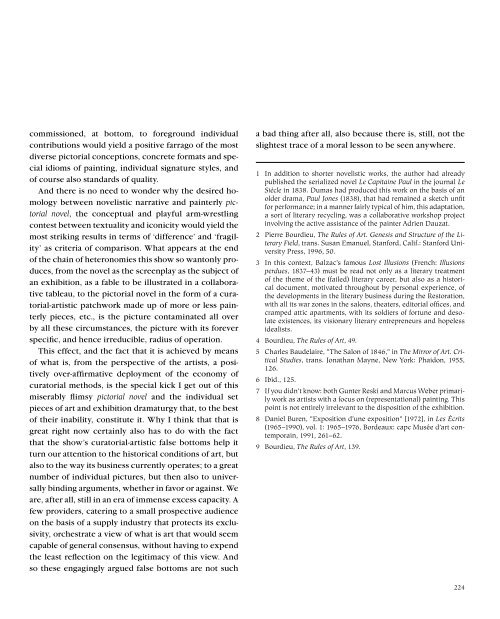EIN BILD ROMAN STÜCKEN A Pictorial Novel In Pieces - Captain ...
EIN BILD ROMAN STÜCKEN A Pictorial Novel In Pieces - Captain ...
EIN BILD ROMAN STÜCKEN A Pictorial Novel In Pieces - Captain ...
Sie wollen auch ein ePaper? Erhöhen Sie die Reichweite Ihrer Titel.
YUMPU macht aus Druck-PDFs automatisch weboptimierte ePaper, die Google liebt.
commissioned, at bottom, to foreground individual<br />
contributions would yield a positive farrago of the most<br />
diverse pictorial conceptions, concrete formats and special<br />
idioms of painting, individual signature styles, and<br />
of course also standards of quality.<br />
And there is no need to wonder why the desired homology<br />
between novelistic narrative and painterly pictorial<br />
novel, the conceptual and playful arm-wrestling<br />
contest between textuality and iconicity would yield the<br />
most striking results in terms of ‘difference’ and ‘fragility’<br />
as criteria of comparison. What appears at the end<br />
of the chain of heteronomies this show so wantonly produces,<br />
from the novel as the screenplay as the subject of<br />
an exhibition, as a fable to be illustrated in a collaborative<br />
tableau, to the pictorial novel in the form of a curatorial-artistic<br />
patchwork made up of more or less painterly<br />
pieces, etc., is the picture contaminated all over<br />
by all these circumstances, the picture with its forever<br />
specific, and hence irreducible, radius of operation.<br />
This effect, and the fact that it is achieved by means<br />
of what is, from the perspective of the artists, a positively<br />
over-affirmative deployment of the economy of<br />
curatorial methods, is the special kick I get out of this<br />
miserably flimsy pictorial novel and the individual set<br />
pieces of art and exhibition dramaturgy that, to the best<br />
of their inability, constitute it. Why I think that that is<br />
great right now certainly also has to do with the fact<br />
that the show’s curatorial-artistic false bottoms help it<br />
turn our attention to the historical conditions of art, but<br />
also to the way its business currently operates; to a great<br />
number of individual pictures, but then also to universally<br />
binding arguments, whether in favor or against. We<br />
are, after all, still in an era of immense excess capacity. A<br />
few providers, catering to a small prospective audience<br />
on the basis of a supply industry that protects its exclusivity,<br />
orchestrate a view of what is art that would seem<br />
capable of general consensus, without having to expend<br />
the least reflection on the legitimacy of this view. And<br />
so these engagingly argued false bottoms are not such<br />
a bad thing after all, also because there is, still, not the<br />
slightest trace of a moral lesson to be seen anywhere.<br />
1 <strong>In</strong> addition to shorter novelistic works, the author had already<br />
published the serialized novel Le Capitaine Paul in the journal Le<br />
Siècle in 1838. Dumas had produced this work on the basis of an<br />
older drama, Paul Jones (1838), that had remained a sketch unfit<br />
for performance; in a manner fairly typical of him, this adaptation,<br />
a sort of literary recycling, was a collaborative workshop project<br />
involving the active assistance of the painter Adrien Dauzat.<br />
2 Pierre Bourdieu, The Rules of Art. Genesis and Structure of the Literary<br />
Field, trans. Susan Emanuel, Stanford, Calif.: Stanford University<br />
Press, 1996, 50.<br />
3 <strong>In</strong> this context, Balzac’s famous Lost Illusions (French: Illusions<br />
perdues, 1837–43) must be read not only as a literary treatment<br />
of the theme of the (failed) literary career, but also as a historical<br />
document, motivated throughout by personal experience, of<br />
the developments in the literary business during the Restoration,<br />
with all its war zones in the salons, theaters, editorial offices, and<br />
cramped attic apartments, with its soldiers of fortune and desolate<br />
existences, its visionary literary entrepreneurs and hopeless<br />
idealists.<br />
4 Bourdieu, The Rules of Art, 49.<br />
5 Charles Baudelaire, “The Salon of 1846,” in The Mirror of Art. Critical<br />
Studies, trans. Jonathan Mayne, New York: Phaidon, 1955,<br />
126.<br />
6 Ibid., 125.<br />
7 If you didn’t know: both Gunter Reski and Marcus Weber primarily<br />
work as artists with a focus on (representational) painting. This<br />
point is not entirely irrelevant to the disposition of the exhibition.<br />
8 Daniel Buren, “Exposition d’une exposition” [1972], in Les Écrits<br />
(1965–1990), vol. 1: 1965–1976, Bordeaux: capc Musée d’art contemporain,<br />
1991, 261–62.<br />
9 Bourdieu, The Rules of Art, 139.<br />
224


